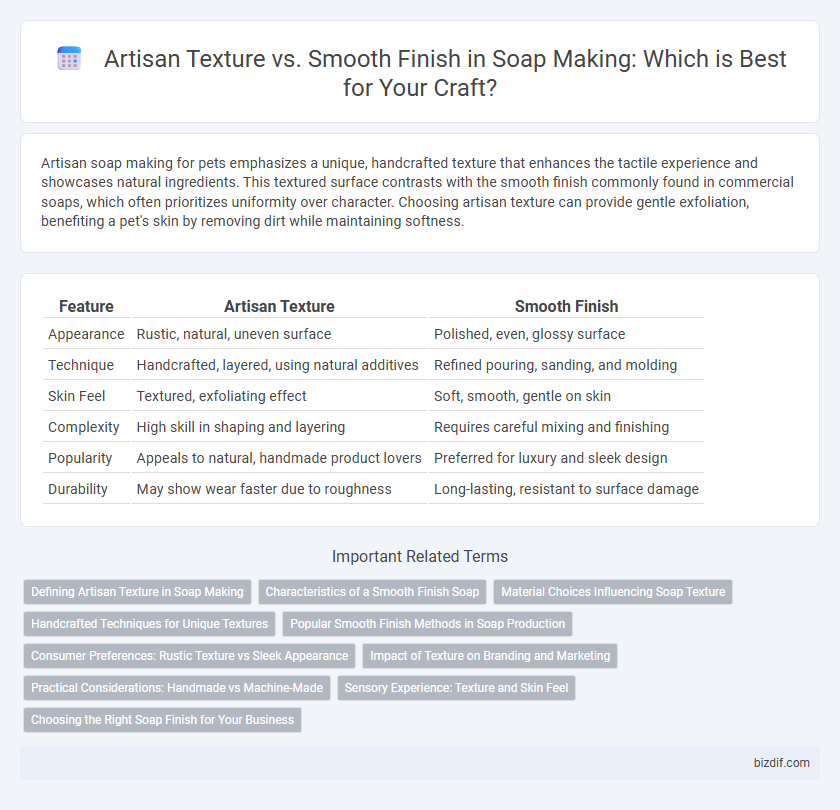Artisan soap making for pets emphasizes a unique, handcrafted texture that enhances the tactile experience and showcases natural ingredients. This textured surface contrasts with the smooth finish commonly found in commercial soaps, which often prioritizes uniformity over character. Choosing artisan texture can provide gentle exfoliation, benefiting a pet's skin by removing dirt while maintaining softness.
Table of Comparison
| Feature | Artisan Texture | Smooth Finish |
|---|---|---|
| Appearance | Rustic, natural, uneven surface | Polished, even, glossy surface |
| Technique | Handcrafted, layered, using natural additives | Refined pouring, sanding, and molding |
| Skin Feel | Textured, exfoliating effect | Soft, smooth, gentle on skin |
| Complexity | High skill in shaping and layering | Requires careful mixing and finishing |
| Popularity | Appeals to natural, handmade product lovers | Preferred for luxury and sleek design |
| Durability | May show wear faster due to roughness | Long-lasting, resistant to surface damage |
Defining Artisan Texture in Soap Making
Artisan texture in soap making refers to the deliberate incorporation of natural inconsistencies and handcrafted elements that enhance the tactile and visual appeal of each bar. This texture is achieved through techniques such as swirling, layering, or embedding botanicals, which create a unique, organic feel distinct from mass-produced soaps. The artisan texture not only adds aesthetic value but also highlights the craftsmanship and individuality behind every soap crafted.
Characteristics of a Smooth Finish Soap
A smooth finish soap is characterized by its uniform surface and refined texture, achieved through meticulous pouring and controlled curing processes. This type of soap often uses finely ground ingredients and stabilizers to reduce air bubbles and imperfections, resulting in a glossy, polished appearance. Smooth finish soaps typically offer a luxurious feel and consistent lather, appealing to those seeking aesthetically pleasing and gentle skincare products.
Material Choices Influencing Soap Texture
Material choices significantly influence soap texture, with natural additives like oats, herbs, or exfoliants creating an artisan, textured finish. Using vegetable oils and butters tends to result in smoother, creamier soaps with softer lather. Synthetic additives and superfatted formulations enhance smoothness, while clays and botanicals contribute to a rustic, handcrafted appearance.
Handcrafted Techniques for Unique Textures
Handcrafted soap making techniques create unique textures by manipulating ingredients, curing times, and molding methods to achieve either an artisan texture or a smooth finish. Techniques such as layering, embedding, and swirling enhance tactile appeal and visual interest, resulting in distinctive, handcrafted bars that differ significantly from mass-produced soaps. These textures not only elevate aesthetic value but also influence exfoliation properties and user experience.
Popular Smooth Finish Methods in Soap Production
Popular smooth finish methods in soap production include cold process soap polishing, hot process soap smoothing, and the use of silicone molds to create sleek textures. Cold process polishing involves gentle sanding or buffing after curing to achieve a refined surface, while hot process smoothing leverages heat to melt and level the soap's outer layer for a glossy effect. Silicone molds contribute to consistent smooth finishes by preventing texture imperfections during the setting phase.
Consumer Preferences: Rustic Texture vs Sleek Appearance
Consumers choosing artisan soap often prefer rustic textures for their natural, handmade appeal that conveys authenticity and uniqueness. In contrast, a smooth finish attracts those seeking a sleek appearance that suggests luxury and refinement. Both textures influence purchasing decisions by aligning with individual values and aesthetic preferences in soap making.
Impact of Texture on Branding and Marketing
Artisan soap texture enhances brand identity by conveying authenticity, craftsmanship, and uniqueness, attracting consumers seeking handmade and natural products. Smooth finish soaps appeal to a market segment prioritizing elegance, luxury, and consistency, often associated with premium quality and refined aesthetics. Texture choice directly influences packaging design, visual marketing strategies, and target audience perception, shaping overall brand positioning in competitive soap markets.
Practical Considerations: Handmade vs Machine-Made
Handmade soaps with an artisan texture often showcase unique, irregular patterns that enhance grip and aesthetic appeal, ideal for niche markets valuing craftsmanship. Machine-made soaps achieve a consistent smooth finish through precise molding and automated processes, optimizing mass production and uniformity. Practical considerations include production scale, consumer preference for texture, and cost efficiency, as handmade soaps typically require more labor and time than machine-made varieties.
Sensory Experience: Texture and Skin Feel
Artisan soap texture offers a rich, tactile experience with its varied surface and natural exfoliants that gently stimulate the skin, enhancing sensory engagement during use. In contrast, soaps with a smooth finish provide a sleek, creamy lather that glides effortlessly, imparting a silky, soothing sensation ideal for sensitive skin. The choice between textured artisan bars and smooth soaps directly influences the skin feel, with texture promoting gentle exfoliation and smooth finish ensuring hydration and softness.
Choosing the Right Soap Finish for Your Business
Artisan soap texture creates a unique, handcrafted appeal that attracts customers seeking natural and rustic aesthetics, while smooth finish soaps convey elegance and professionalism ideal for luxury markets. Selecting the right soap finish depends on your target audience and brand identity, with textured soaps emphasizing individuality and smooth soaps offering consistent quality. Balancing visual appeal and customer expectations enhances product differentiation and drives sales growth in competitive soap markets.
Artisan Texture vs Smooth Finish Infographic

 bizdif.com
bizdif.com